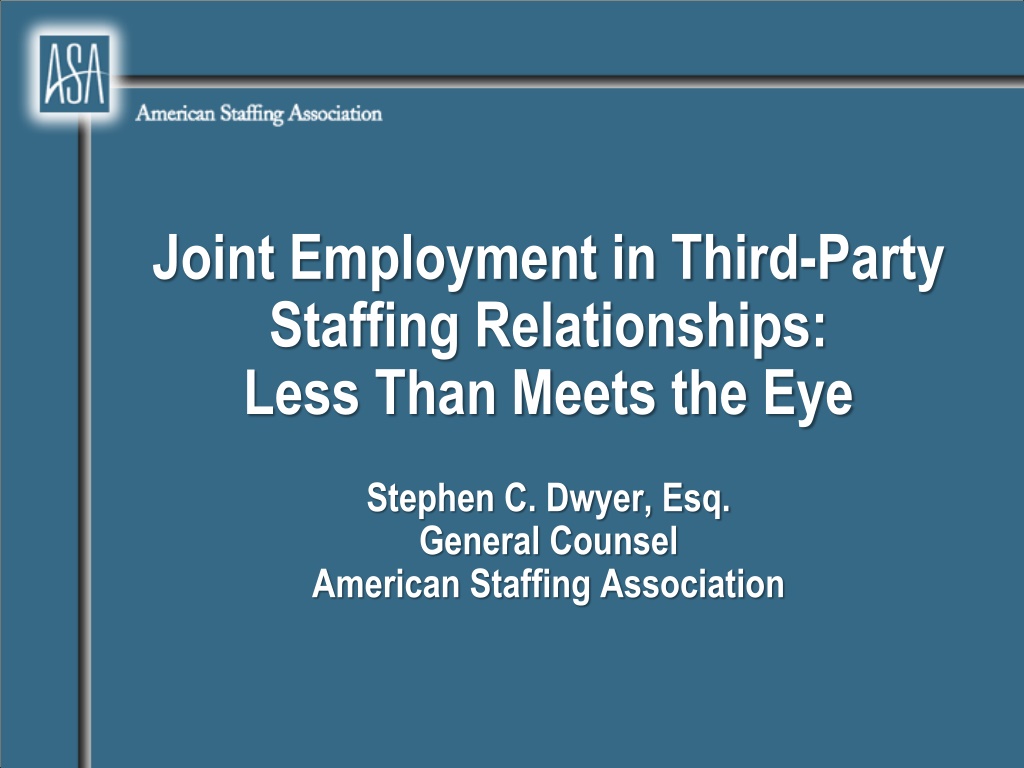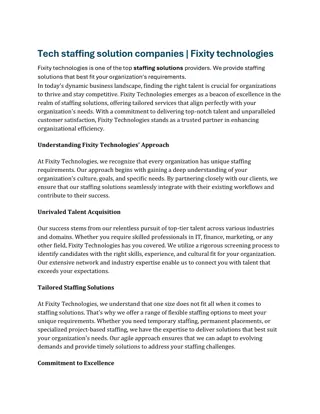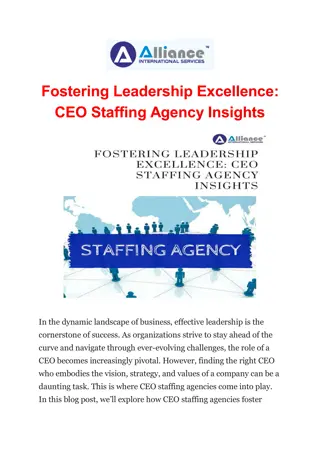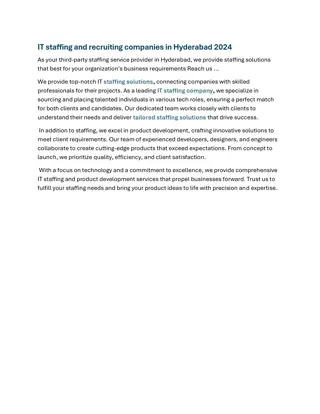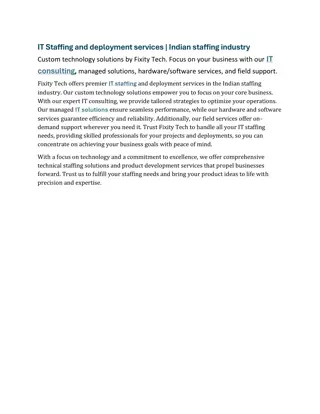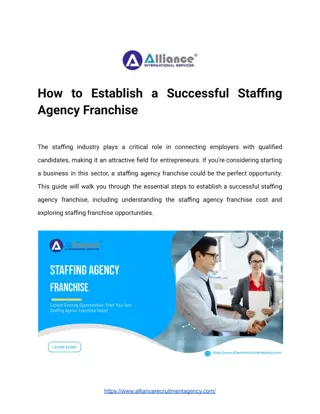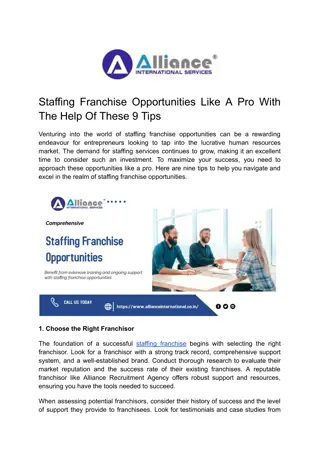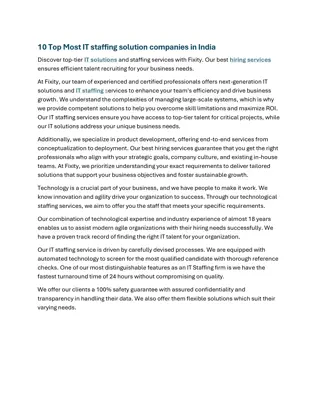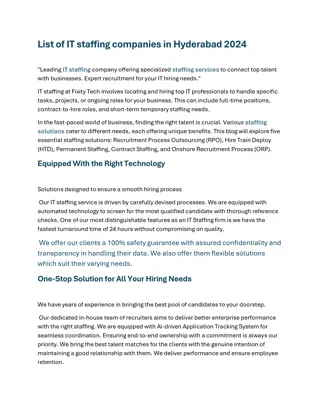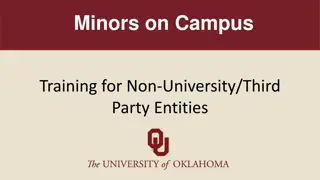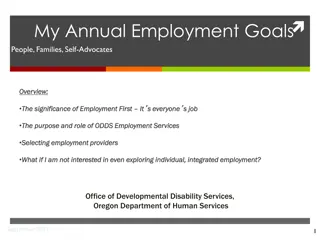Understanding Joint Employment in Third-Party Staffing Relationships
Joint employment in staffing relationships involves legal rights and duties between multiple employers concerning the same employees. This presentation by Stephen C. Dwyer, Esq., General Counsel at the American Staffing Association, discusses the nuances of joint employment, the economic advantages of flexible staffing, and the roles of staffing firms and clients in managing these relationships effectively. It emphasizes the importance of informed decision-making and proper management to address joint employment considerations.
Download Presentation

Please find below an Image/Link to download the presentation.
The content on the website is provided AS IS for your information and personal use only. It may not be sold, licensed, or shared on other websites without obtaining consent from the author. Download presentation by click this link. If you encounter any issues during the download, it is possible that the publisher has removed the file from their server.
E N D
Presentation Transcript
Joint Employment in Third-Party Staffing Relationships: Less Than Meets the Eye Stephen C. Dwyer, Esq. General Counsel American Staffing Association
The information in this presentation should not be relied on as legal advice. Experienced legal counsel should be consulted on specific matters relating to the issues covered.
Joint EmploymentThe Bottom Line Economic advantages of flexible staffing arrangements outweigh joint employment considerations which can be addressed with proper management Joint employment in staffing relationships is nothing new, despite recent developments Joint employment considerations are no more onerous than what companies face when they hire their own employees and in some cases are less when staffing services are used
Joint EmploymentThe Bottom Line The best staffing firms are human resource partners, not labor brokers Clients must screen and choose knowledgeable staffing providers A knowledgeable staffing firm helps protect The staffing firm Temporary workers Clients Just because other staffing firms do it this way does not mean they are right
Joint Employment Defined A commercial relationship between two or more employers in which each has legal rights and duties as an employer with respect to the same employees
Staffing Firms Employer Role Recruits, screens, hires, and completes the Form I-9 Determines wage rates and benefits Pays wages and employment taxes Maintains temporary worker handbooks, policies, complaint mechanisms Provides workers compensation Handles temporary employee complaints Has the right to discipline, reassign, or terminate Is responsible for unemployment insurance
Staffing Clients Employer Role Determines length of assignment May review r sum s, conduct interviews, and select candidates Directs and controls temporary employees day-to-day work activities
Joint Employment Issues EEO (Title VII, ADA, workplace harassment) Wage and hour law (FLSA) Family and medical leave (FMLA) Workplace safety (OSH Act) Workers compensation Employee benefits (ACA, Erisa) Union organizing and collective bargaining (NLRA) Indemnification
Equal Employment Opportunity
Title VII of the Civil Rights Act of 1964 Who s Covered? Anyone who exercises right of control over the worker EEOC: Any firm that can affect a worker s job opportunities can be liable, even if not an employer or joint employer
Title VIIDuties Staffing firms and clients bothhave a duty not to discriminate against temporary employees Staffing firms and clients bothhave a duty not to harass temporary employees Staffing firms and clients have the same duties to temporary employees as to their internal employees
Title VIIJob Orders Staffing firms have a legal duty to refuse to assign employees to clients that discriminate Staffing firms that accede to discriminatory client job orders can be liable under Title VII
Americans With Disabilities Act (ADA)
Americans With Disabilities Act Staffing firms and clients are joint employers under the ADA and, generally, neither may ask medical questions before an assignment has been offered
ADA Duty to Accommodate Staffing firms and clients both will have a duty to accommodate temporary employees disabilities Staffing firms and clients should share accommodation costs Failure by one to contribute may cause undue hardship to the other
Fair Labor Standards Act (FLSA)
Fair Labor Standards Act Staffing firms have primary responsibility for keeping wage and hour records Decades of case law and older DOL guidance: Clients generally are joint employers for overtime DOL joint employment guidance 2016: Merely reaffirms what we already knew staffing firms and clients typically are joint employers
Fair Labor Standards Act Staffing firms and clients that are joint employers will have joint and several liability for overtime Clients should screen and audit staffing firm practices
Family and Medical Leave Act (FMLA)
Family and Medical Leave Act Decades of case law and FMLA regulations: Staffing firms and clients typically are joint employers Temporary workers who return from FMLA leave are entitled to resume their assignments (assuming they still exist), even if it means pulling a replacement worker off the job
Workplace Safety: Occupational Safety and Health Act
Workplace Safety Staffing firms and clients are joint employers of temporary workers, and thus both are responsible for temporary worker safety
OSHA Temporary Worker Safety Initiative New Resources Temporary worker web page (September 2013) Guidance documents Recommended practices Informational bulletins Record-keeping Personal protective equipment (PPE) Whistleblower protection rights Additional expected bulletins (training, lockout/tagout, hearing conversation, hazard communication, respiratory protection, powered industrial vehicles, etc.)
Workplace SafetyOSH Act Temporary workers are entitled to the same training and protections as any other worker Regardless of Position Length of assignment Cost of training
Workplace SafetyOSH Act OSHA Record-Keeping Bulletin Supervising employer must record temporary worker injuries on OSHA 300 log; client typically will have record-keeping responsibility Supervision and control: key for responsibility Day-to-day supervision over means and manner of work On-site presence for administrative tasks does not equate to supervision and control
Work Site Evaluation and Training the client s work site Occupational safety and health responsibilities should be assigned and defined in the parties contract New project orientation Staffing firms: General training applicable to different occupational settings Clients: Site-specific training that is the same as that provided to client s own employees Prior to assignment, staffing firm and client evaluate
Personal Protective Equipment OSHA PPE Bulletin: Clients generally responsible for PPE Selecting Providing Training Ensuring actual use Staffing firm: Reasonable steps to ensure provision of PPE Temporary employees cannot be required to pay for PPE
Workers Compensation
Workers Compensation Special (joint) employer status protects staffing firm clients In most states, staffing firms and clients are immune from tort liability if the assigned employee sues them for a workplace injury But if clients disclaim joint employer status in staffing contracts, they may waive immunity from tort liability
Workers Compensation Staffing firm is a general employer Staffing client will be a special employer if Client supervises the work Employee consents to relationship Work done is that of the client
Benefits Liability (ACA, Erisa)
Benefits Liability Clients should review their benefit plans with counsel to ensure that temporary, leased, and contract employees are clearly excluded Courts have upheld temporary employee agreements to waive client benefits; agreements should be tailored to particular client plans
Benefits Liability: Time Limits Are Not the Answer Length of assignment, alone, does not create benefits liability Limiting assignments does not reduce exposure in non-benefits areas, e.g., equal employment opportunity compliance, workplace safety, wage and hour law Churning is not cost-effective and harms employees who need work
Benefits Liability: Affordable Care Act ACA responsibility falls on the common law employer generally the staffing firm If client is the employer, staffing firm can offer coverage on client s behalf if it charges client more for the employees who enroll
Joint Employment Under the National Labor Relations Act Joint employment means two or more employers that share or codetermine, and meaningfully affect, essential terms and conditions of employment (e.g., hiring, firing, discipline, supervision, and direction)
NLRA Obligations of Joint Employers Must bargain over terms and conditions of employment they meaningfully affect Subject to liability for unfair labor practices committed by other joint employer(s)
BrowningFerris: Joint Employment Standard Before ruling: Employer control had to be direct and immediate and not limited or routine e.g., building management company was not a joint employer with janitorial company even though it dictated the number of workers, communicated specific work assignments and directives to supplier s manager, and exercised ongoing performance oversight After ruling: Indirect or limited control will suffice; right to control may be enough, even if not exercised
BrowningFerris: No Major Impact on Staffing Expected New definition of joint employer poses no new risk since clients had long been held joint employers under the old rule if they dictated employees hours and duties, directly supervised work, and terminated employees Unions represent only 6% of private-sector workers, and temporary employees have shown little interest in unions
Indemnification: Whose Business Is It? Staffing firms are in the staffing business, not the many different businesses in which clients operate A staffing firm and its client should be responsible for those matters over which each has knowledge and control A staffing firm and its client do not know or control each other s business operations A contract s indemnity language should allocate responsibility according to the practical realities and responsibilities of each party s business
Less Than Meets the Eye
Putting It All Together Workplace flexibility trumps joint employment concerns Joint employment issues are of no greater concern than those pertaining to clients own employees and, in some cases, are less Concerns can be mitigated by working with staffing firms that are human resource partners and are knowledgeable about and compliant with employment laws
Released in 20158th Edition of Co-Employment: Employer Liability Issues in Third-Party Staffing Arrangements By Ed Lenz, ASA senior counsel Available in print and as an ebook americanstaffing.net/books
